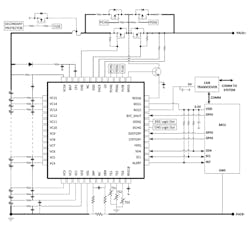Strengthen Li-Ion-Powered Product Safety with Enhanced Monitoring and Control
Download this article in PDF format.
Lithium-ion batteries represent one of the best inventions of the 20th century. They have one of the highest energy-density specifications of any battery made (energy density is the quantity of energy stored in a given space or volume). Small size and high power make these batteries suitable for many portable applications. Cordless power tools, lawn equipment, and eBikes all use them. Hybrid and electric vehicles have adopted the Li-ion as their main power source, too.
All this good news is offset by the fact that most Li-ion batteries are potentially small bombs. If they’re overloaded in some way or their temperature exceeded, they can catch fire or explode. For this reason, products incorporating lithium-ion, lithium-polymer, and lithium-phosphate batteries must have some measurement capability and protection capability.
Sponsored Resources:
- CURRENTly questioning the accuracy of your battery monitor?
- Improving voltage measurement accuracy in battery monitoring systems
- Improving temperature measurement accuracy in battery monitoring systems
Critical Measurements and the Need for Accuracy
The secret to eliminating a lithium battery’s fire and explosion problems is to operate the battery well within its specifications. For instance, maintain the voltage in the center of the range specified. And never exceed the charging voltage or current, the maximum load current, and the operating temperature.
All of these factors should be monitored and accurately controlled. If any critical measurement isn’t correct, the system should shut down. Typically, the goal is some circuit or device connected in series with the load so that if any overload or underload occurs, all loads are automatically disconnected.
Another critical factor is determining the overall health of the battery. For example, battery-pack current measurements are important for gauging. Gauging determines the state of charge or health of a battery to predict the remaining battery capacity, including the maximum runtime of the powered device.
One More Factor to Consider
Operating a lithium-based battery outside of the cell manufacturer’s specified temperature range can cause a major incident. The main risk is thermal runaway, which can result in fire or explosion. To eliminate this problem and comply with existing standards requirements, the battery must be disabled whenever the cell temperature is outside this specified temperature range. Knowing when to disable the battery depends on the accuracy of the product’s temperature measurement capability.
Safety actions must be detected over a very narrow measurement range to ensure that the host device isn’t damaged. This calls for the accurate measurement of voltage, current, and temperature. So how does a designer get all of it done?
Easier Said than Done
Making precise and accurate measurements is the dominating feature of any battery protection system. This is no easy undertaking. Designing such a system is a major task with a major investment in time and money. However, that may not be necessary anymore. Texas Instruments has developed ICs that take care of all of these aspects, namely the BQ76942 and BQ76952.
Both ICs are completely integrated battery monitors with full protection functions for Li-ion, Li-polymer and LiFePO4 battery packs. The BQ76942 handles 3 to 10 series-connected cells while the BQ76952 can serve 3 to 16 cells. Both devices are designed to work with a host microcontroller and external MOSFET switches in series with the battery bus line. They measure cell voltage, current, and temperature, and then store and communicate the data. Serial I/O ports include a 400-kb/s I2C, SPI, and HDQ one-wire.
These devices have two independent ADCs—both are the delta-sigma type for high-resolution measurement. One ADC, called a coulomb counter, is dedicated to battery current measurement. A low-value resistor is connected in series with the low side of the battery. The resistor value is small (1 mΩ or less) and the ADC voltage measurement can be less than 50 mV. The other ADC is devoted to cell voltage measurements, with a precision of better than 10 mV.
The figure shows how the BQ76952 is used. Notice on the left is the battery pack where each cell is monitored. Also make note of the series resistor for current measurement at the bottom of the figure. At the top is the external series disconnect switch with its multiple MOSFETs.
Next-generation battery monitors like these, if built into products, will provide full battery safety while improving accuracy and extending runtime. Today, you must provide some of these features in the lithium battery-based product. These ICs take away most of the critical design issues and give you a product that will pass its safety certifications.
Summing Up
Accurate monitoring of battery voltage, current, and temperature is necessary to ensure the safe operation of battery-powered systems such as vacuum cleaners, power tools, and eBikes. The secret to effective protection of lithium-battery-powered devices is measurement accuracy. This isn’t an option in designing such portable devices. Now, you needn’t design a suitable system—Texas Instruments’ BQ76942 and BQ76952 handle it all with minimum effort on your part.
Sponsored Resources:

